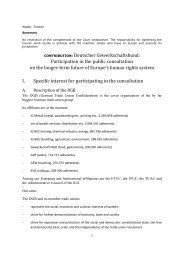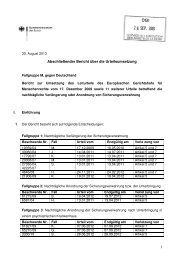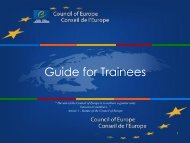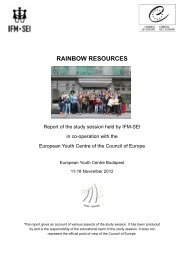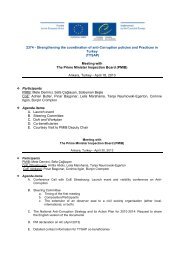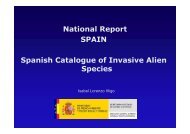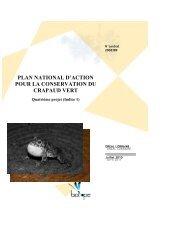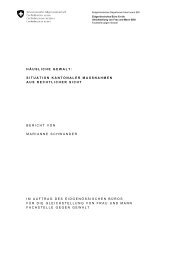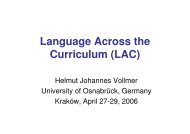Tanja Tajmel
Tanja Tajmel
Tanja Tajmel
Create successful ePaper yourself
Turn your PDF publications into a flip-book with our unique Google optimized e-Paper software.
<strong>Tanja</strong> <strong>Tajmel</strong><br />
Humboldt-Universität zu Berlin<br />
Language dimensions<br />
in learning and teaching science<br />
Seminar on languages of schooling in all subjects<br />
Council of Europe, 27-28 September 2012<br />
©<strong>Tanja</strong> <strong>Tajmel</strong> 2012
Requested language dimensions in school<br />
1. On general level<br />
2. On domain- and subject specific level<br />
• National educational standards<br />
• Subject specific curricula<br />
3. On teaching and operational level<br />
©<strong>Tanja</strong> <strong>Tajmel</strong> 2012
Language g functions<br />
naming, reporting, narrating,<br />
describing, illustrating,<br />
explaining, reasoning,<br />
comparing, distinguishing,<br />
retrieving information,<br />
interpreting, arguing,<br />
summarising, recording, protocolling<br />
…<br />
©<strong>Tanja</strong> <strong>Tajmel</strong> 2012
Requested language dimensions in school<br />
1. On general level<br />
2. On domain- and subject specific level<br />
• National educational standards<br />
• Subject specific curricula<br />
3. On teaching and operational level<br />
©<strong>Tanja</strong> <strong>Tajmel</strong> 2012
Fields of competences in<br />
physics/chemistry/biology (KMK 2004)<br />
Scientific<br />
knowledge (F)<br />
Acquisition of<br />
knowledge (E)<br />
Communication<br />
(K)<br />
Evaluation (B)<br />
©<strong>Tanja</strong> <strong>Tajmel</strong> 2012
Fields of competences in the sciences (KMK 2004)<br />
Acquisition of<br />
knowledge (E)<br />
E1 Students describe phenomena and lead<br />
them back to common physical contexts<br />
E2 Students t select data and information from<br />
different sources to process the tasks …<br />
E6 Students propose hypotheses on basis of<br />
simple examples<br />
E10 Students assess the validity of empirical<br />
outcomes and their generalisation<br />
©<strong>Tanja</strong> <strong>Tajmel</strong> 2012
Which language g functions are (considered to be)<br />
required for a specific subject?<br />
Analysis of the subject specific<br />
language functions<br />
(educational standards and curricula)<br />
Top<br />
down<br />
©<strong>Tanja</strong> <strong>Tajmel</strong> 2012
Requested language dimensions in school<br />
1. On general level<br />
2. On domain- and subject specific level<br />
• National educational standards<br />
• Subject specific curricula<br />
3. On teaching and operational level<br />
©<strong>Tanja</strong> <strong>Tajmel</strong> 2012
Which language g functions are (considered to be)<br />
required for a specific subject?<br />
Analysis of the subject specific<br />
language functions<br />
(educational standards and curricula)<br />
Top<br />
down<br />
How to characterise the required<br />
language functions on an operational<br />
level? l?<br />
Analysis of the required linguistic<br />
means; raising the language<br />
awareness of teachers<br />
Bottom<br />
up<br />
Analysis framework<br />
©<strong>Tanja</strong> <strong>Tajmel</strong> 2012
©<strong>Tanja</strong> <strong>Tajmel</strong> 2012<br />
An example
1. Gründe für Sprache im Fachunterricht<br />
Curriculum for Physics, Berlin (SenBJS 2006)<br />
Field of competence: Acquisition of knowledge<br />
Grade 7/8<br />
The students …<br />
… notice and observe natural phenomena.<br />
Top<br />
down<br />
… describe these phenomena.<br />
©<strong>Tanja</strong> <strong>Tajmel</strong> 2012
6. Bedarfsanalyse<br />
The students observe and describe a phenomenon<br />
Which linguistic means are necessary<br />
to describe this phenomenon<br />
precisely?<br />
Bottom<br />
up<br />
©<strong>Tanja</strong> <strong>Tajmel</strong> 2012
2. Sensibilisierung<br />
Whichh linguistici i means are necessary<br />
to describe this phenomenon<br />
precisely?<br />
You will recognise it immediatily,<br />
when you take the students<br />
perspective!*<br />
Bottom<br />
up<br />
Observe the phenomenon!<br />
Describe in everyday language,<br />
what you observe!<br />
Use your best foreign language!<br />
*<strong>Tajmel</strong>, T. (2009), Preparing Teachers for Cultural and Linguistic Diversity in the<br />
Science Classroom, in: <strong>Tajmel</strong>, T. und Starl, K. (Eds.), Science Education Unlimited.<br />
Approaches to Equal Opportunities in Learning Science, Waxmann, Münster/New York.<br />
©<strong>Tanja</strong> <strong>Tajmel</strong> 2012
Top<br />
down<br />
actually required<br />
linguistic i i means<br />
Bottom<br />
up<br />
©<strong>Tanja</strong> <strong>Tajmel</strong> 2012
Analysis framework for language functions (<strong>Tajmel</strong> 2011)<br />
1. Educational standard<br />
Top down<br />
2.<br />
Relevant language<br />
function<br />
3. Level of expectations<br />
Bottom up<br />
4.<br />
Relevant linguistic<br />
means:<br />
- word level<br />
- senctence level<br />
- text level<br />
actually required<br />
linguistic means<br />
Modified d and extended<br />
d<br />
5.<br />
educational standard<br />
©<strong>Tanja</strong> <strong>Tajmel</strong> 2012
Analysis framework for language functions (<strong>Tajmel</strong> 2011)<br />
1. Educational standard<br />
2.<br />
Relevant language<br />
function<br />
Acquisition of knowledge (F): Observing and<br />
describing phenomena<br />
Basic concept: interaction, buoyant force<br />
Describing<br />
A stone is hanging on one side of a coathanger, on<br />
the other side there are weights hanging. The stone<br />
3. Level of expectations<br />
is as heavy as the weights. When the stone is<br />
dipped into water, the side with the stone lifts and<br />
the coathanger is inclined.<br />
4.<br />
Relevant linguistic<br />
means:<br />
- word level<br />
- senctence level<br />
- text level<br />
- stone, coathanger, weights, horizontal,<br />
inclined, to dip into, to lift, light , heavy, …<br />
- conditional clause, passiv form<br />
Modified d and extended<br />
d<br />
5.<br />
educational standard<br />
©<strong>Tanja</strong> <strong>Tajmel</strong> 2012<br />
The students describe an experiment to<br />
buoyant force by using general terms, such as<br />
weights, inclined, to dip into, light – heavy, …
2. Sensibilisierung<br />
(beam) balance<br />
coathanger<br />
balance beam<br />
weight(-s)<br />
to submerge…<br />
to dip in ...<br />
balance<br />
light - heavy<br />
horizontal – inclined - upright<br />
<strong>Tajmel</strong>, T. et al. (2009): Floating – Sinking. Teaching Modules for grade 5-8. In: <strong>Tajmel</strong>, <strong>Tanja</strong> and Starl, Klaus<br />
(Eds.), Science Education Unlimited. Approaches to Equal Opportunities in Learning Science, Waxmann,<br />
Münster/New York 2009<br />
©<strong>Tanja</strong> <strong>Tajmel</strong> 2012
Thank you for your<br />
attention!<br />
tanja.tajmel@physik.hu-berlin.de<br />
©<strong>Tanja</strong> <strong>Tajmel</strong> 2012
Teaching material<br />
Kleiderbügelexperiment<br />
Book + CD-ROM with video of the<br />
©<strong>Tanja</strong> <strong>Tajmel</strong> 2012<br />
„Coathanger-Experiment“
References<br />
Kultusministerkonferenz (KMK) (2005): Bildungsstandards im Fach Physik<br />
für den Mittleren Schulabschluss (Beschluss vom 16.12.2004). Neuwied:<br />
Luchterhand.<br />
Senatsverwaltung für Bildung, Jugend und Sport Berlin (SenBJS) (2006).<br />
Rahmenlehrplan für die Sekundarstufe I, Jahrgangsstufe 7-10, Physik. Berlin.<br />
<strong>Tajmel</strong>, T./ Starl, K. (Eds.) (2009): Science Education Unlimited. Approaches<br />
to Equal Opportunities in Learning Science. Münster, New York: Waxmann<br />
<strong>Tajmel</strong>, T. (2010), DaZ-Förderung im naturwissenschaftlichen Fachunterricht,<br />
in: Ahrenholz, Bernt (Hrsg.), Fachunterricht und Deutsch als Zweitsprache, Narr,<br />
Tübingen.<br />
<strong>Tajmel</strong>, T. (2011): Sprachliche Lernziele im naturwissenschaftlichen Unterricht.<br />
ProDaZ, Uni Duisburg-Essen, http://www.uni-due.de/imperia/md/content/prodaz<br />
Thürmann, E. & Vollmer, H. J. (2010): A Framework of Language<br />
Competencies Across the Curriculum. Language(s) in and for Inclusive Education<br />
in Northrhine-Westfalia (Germany). Strasbourg: Council of Europe,<br />
http://www.coe.int/t/dg4/linguistic/Source/Checklist_Nord-Rhein-<br />
Westphalia_en.doc<br />
Vollmer, H. J. (2010): Items for a description of linguistic competence in the<br />
language of schooling necessary for learning/teaching sciences (end of<br />
compulsory education). Strasbourg: Council of Europe.<br />
http://www.coe.int/t/dg4/linguistic/Source/Source2010_ForumGeneva/1-LISsciences2010_EN.pdf<br />
©<strong>Tanja</strong> <strong>Tajmel</strong> 2012



